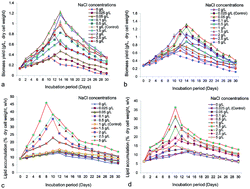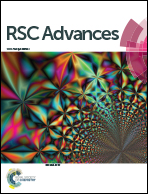An integrated salinity-driven workflow for rapid lipid enhancement in green microalgae for biodiesel application
Abstract
A laboratory based integrated approach was undertaken for improvement of lipid accumulation in green microalgae under sodium chloride (NaCl) stress. The maximum biomass yields (1.22 ± 0.04 g L−1 in Chlorella and 1.31 ± 0.04 g L−1 in Chlorococcum) were obtained in the media with initial NaCl concentrations at 2 g L−1 (for Chlorella) and 0.05 g L−1 (for Chlorococcum) after 14 days of culture. Interestingly, maximum lipid accumulation obtained was 45.8 ± 0.4% w/v for Chlorella (on day eight) and 36.33 ± 0.56% w/v for Chlorococcum (on day ten) at an exposure of 5 g L−1 and 1.5 g L−1 NaCl concentrations, respectively. Fatty acid profiles of methyl esters for neutral and polar lipid fractions showed the presence of myristic (C14:0), palmitic (C16:0), palmitoleic (C16:1), oleic (C18:1) and linoleic (C18:2) acids as major fatty acids. Fluorescence intensities (% positive Nile red stained cells) of neutral and polar lipid fractions were also higher in NaCl stress conditions. A significant correlation between polar lipid and neutral lipid was found in both Chlorella (r2 = 0.979) and Chlorococcum (r2 = 0.972). Flow cytometric study demonstrated a positive fluorescence signal for neutral and polar lipid bodies related to Nile red fluorescence. Associated biochemical changes, like those in total chlorophyll, carotenoid, carbohydrate and protein contents, were determined under variable NaCl concentrations. The elemental compositions (CHNS) and CO2 fixation rate were assessed using high lipid yielding cells under optimum NaCl concentrations. Biodiesel fuel properties were obtained from high lipid yielding cells of the test microalgae and compared with Indian and international diesel standards. Finally large-scale cultivation of Chlorella ellipsoidea was performed in a hybrid photobioreactor (800 L capacity) and the highest biomass and lipid content obtained was 1.66 ± 0.09 g L−1 (at 8 days) and 54.73 ± 1.78% w/v (at 10 days) at 5 g L−1 NaCl respectively. This optimized NaCl concentration makes it an economical substitute for biodiesel production on a large scale.


 Please wait while we load your content...
Please wait while we load your content...